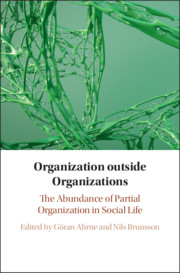Book contents
- Organization outside Organizations
- Organization outside Organizations
- Copyright page
- Contents
- Preface
- Contributors
- Introduction
- Part 1 Rules, Sanctions, Membership
- Part 2 Organization in and around Markets
- Part 3 Networks and Other Social Relationships
- 9 The Inter-Firm Network as Partial Organization?
- 10 An Organized Network: World Economic Forum and the Partial Organizing of Global Agendas
- 11 Organizing Intimacy
- 12 How Is ‘Organized Crime’ Organized?
- 13 Brotherhood as an Organized Social Relationship
- Part 4 Social Movements and Collective Action
- Part 5 The Partial Organization of Formal Organizations
- Conclusion
- Index
- References
13 - Brotherhood as an Organized Social Relationship
from Part 3 - Networks and Other Social Relationships
Published online by Cambridge University Press: 11 July 2019
- Organization outside Organizations
- Organization outside Organizations
- Copyright page
- Contents
- Preface
- Contributors
- Introduction
- Part 1 Rules, Sanctions, Membership
- Part 2 Organization in and around Markets
- Part 3 Networks and Other Social Relationships
- 9 The Inter-Firm Network as Partial Organization?
- 10 An Organized Network: World Economic Forum and the Partial Organizing of Global Agendas
- 11 Organizing Intimacy
- 12 How Is ‘Organized Crime’ Organized?
- 13 Brotherhood as an Organized Social Relationship
- Part 4 Social Movements and Collective Action
- Part 5 The Partial Organization of Formal Organizations
- Conclusion
- Index
- References
Summary
The argument of this chapter is that brotherhood can be conceptualized as a partially organized relationship, based on membership and rules. To illustrate the conceptualization, the chapter draws examples from three different arenas where there is a strong rhetorical emphasis on brotherhood, or fraternity: the military, motorcycle clubs, and monasteries. Membership determines who is a brother or not and while the brotherly relationship sometimes extends beyond the cessation of membership in a formal organization, it presupposes membership at some point. Rules clarify important components of brotherhood including homogeneous relations among all brothers (or sisters). This makes a crucial difference relative to friendship, which is a type of relationship that can even be a threat for brotherhood. In areas where collectivist ideology, homogeneity of relationships, and requests on loyalty are especially forceful, personal or friendly relations between individual members cannot compensate for failure as a “brother.” Brotherhood justifies sacrifice of individual needs to collective demands, and this may include the sacrifice of a personal relation.
- Type
- Chapter
- Information
- Organization outside OrganizationsThe Abundance of Partial Organization in Social Life, pp. 271 - 290Publisher: Cambridge University PressPrint publication year: 2019
References
- 2
- Cited by

